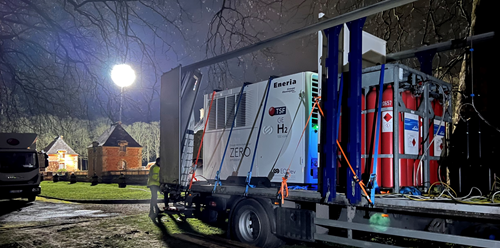News
Netflix tests H2 for zero emission filming
For the first time in France, an EODev GEH2 electro-H2 generator, proposed by Eneria, accompanied the technical means provider TSF on the shooting of a Netflix series, replacing a thermal unit. One evening last May, the film crew used zero-emission electricity in the park of the Château de Courances to power a lighting system designed to reproduce the effects of a full moon night.

Netflix's request allowed TSF to test, in real conditions, the implementation of a mobile GEH2 solution; the electro-H2 generator being placed on a 19-ton truck which also carried 44 kg of H2 compressed to 200 bar and an expansion plate. The fully mobile installation was thus able to follow the film crew around the park with a range of around 12 hours at full power and a potential saving of almost 700 kg of CO2 compared to the use of a diesel unit.
In addition to the absence of harmful emissions, the use of a GEH2, which is relatively silent, made it possible to supply the energy necessary for the use of filming equipment without it being disturbed by the noise of a diesel generator. An 18 kW HMI Daylight balloon simulating the light of the moon was used to provide night-time lighting to accompany the actors around the castle.
Anthony Vernizeau, Sales Manager at EODev said, "Until now we have been offering the GEH2 in stationary mode. Netflix's request to TSF has enabled us to develop a mobile solution that is totally relevant for cinema, but not only. In fact, we have already received requests in the U.S. and Canada for similar applications but also for off-grid electric vehicle charging."
This first promising experiment confirms TSF in the construction of its hydrogen offer for the cinema industry, as Danys Bruyère, TSF's Deputy Managing Director of Technologies said, "It was a great experience. I think a lot of people in the film industry still don't know the potential of this kind of solution, and we're proud to be a forerunner in this field. It also allows Netflix to consider future filming without emissions."
This is more crucial as many areas, particularly urban areas, will become low-emission zones. Whether on construction sites or film sets that generally use diesel generators, the GEH2 has demonstrated its effectiveness as well as its clean energy efficiency.
Laurent Orvoën, Eneria's New Energy Development Sales Manager said, "This was a first for the mobile version, but, as usual, the GEH2 has once again demonstrated that it can meet all expectations without any problems, whatever the circumstances. We are confident that the transition will accelerate, and we are convinced that hydrogen and the clean electro-hydrogen solutions developed by EODev will become indispensable for many sectors. We are investing for the future."
In this context, it should also be recalled that the Centre National du Cinéma et de l'Image Animée, a government body that allocates, among other things, state credits for the development of television projects, has established a roadmap in 2021 to consider the environmental impact of the productions to which it contributes financially; a roadmap whose specifications will be precisely defined this year, with obligations applicable from 2024.

